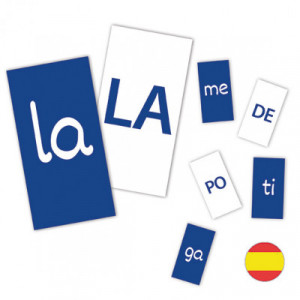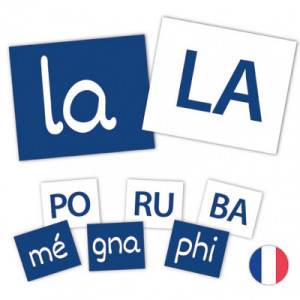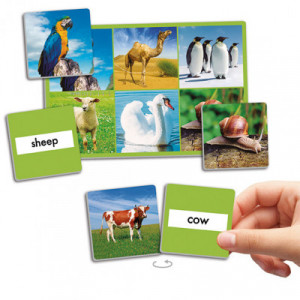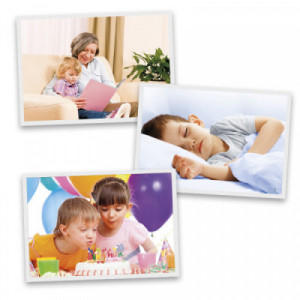Speech therapists and pathologists
This section focuses on speech therapists, phoniatrics and hearing and language teachers. You will find educational materials and games to use in your sessions or classes. With them you will be able to work the correct positioning of lips, tongue, jaw and palate; train coordination and strength of orofacial musculature; practice the correct articulation of different phonemes, exercise breathing and breath.
Also, the games and materials we have selected will also allow you to work on reading initiation, letter recognition, word association with images, vocabulary acquisition and language development, in a playful and entertaining way for children.
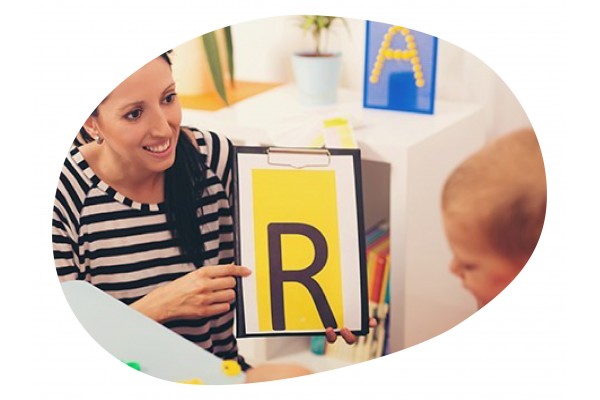
Lecto-bits cards with phonetic syllables for learning to read and improving reading skills
Logo-bits cards with all the consonant clusters for improving pronunciation according...
Lecto-bits de syllabes simples pour soutenir la parole et améliorer la lecture
Logo-bits de capacité articulatoire pour corriger la prononciation selon le point...
Difference between speech therapist, speech therapist and otolaryngologist
They are specialists who deal with the problems inherent in speech and language disorders. These are terms that are often used as synonyms, but in reality they allude to different specialties.
- Speech-language pathologists diagnose, prevent and treat children and adults who suffer from disorders of voice, speech, and oral and written language.
- The speech therapist, speech and language therapist or speech-language pathologist is a physician who specializes in the diagnosis and rehabilitation of the auditory and phonographic functions of patients.
- An otolaryngologist is a physician who diagnoses and provides surgical treatment for throat, nasal and hearing disorders.
Fields of activity of the Phoniatrics Department
It's a medical specialty. The speech therapist decides the rehabilitation or re-education strategy of the patient from a psychological and neurological point of view. Its approach is multidisciplinary and encompasses medication, education, food, lifestyle and linguistics. Its field of action includes rehabilitation, among other pathologies of:
- Childhood language development disorders.
- Aphasia, or language disorders in adult patients.
- Hearing disorders.
- Dysphonia, or voice disorders.
- Dysarthria, stuttering, functional joint disorder and other speech disorders.
- Swallowing disorders.
Field of action of Speech Therapy
Speech therapy is concerned with the diagnosis and treatment of communication disorders caused by pathologies affecting language, voice and speech. It also approaches treatment from a multidisciplinary perspective: health, education, welfare and social, among others. Its field of action includes, among others, the following pathologies:
- Language and phonological delays.
- Dyslalias: phonological and phonetic.
- Language disorders caused by social deprivation, or multicultural contexts.
- Severe cognitive and sensory impairment, such as deafness, deafblindness, or visual impairment.
- Language disorders of neurological origin, such as motor deficits due to cerebral palsy.
- Delay in reading and writing caused by dyslexia, dysgraphia or dyscalculia, among others.
- Disorders acquired through neurological injury, such as aphasia, dysarthria, acquired dyslexia or amusia.
- Disorders associated with degenerative processes caused by infections or dementias.
- Speech fluency disorder due to emotional causes, such as stuttering.
- Voice and MRI disorders, such as organic dysphonia, laryngectomies or reconstructive surgery.
- Structural disorders of the orofacial functions due to tumours, structural alterations or tics.
- nonverbal function disorders, such as problems with swallowing
- Disorders linked to mental problems, such as mutism and inhibition of language due to behavioral causes.
Speech therapy material for learning through play
In Akros you can find all the speech therapy material you need to learn by playing, and to teach others through games, entertaining and easy to learn.
Children need to be motivated to do an activity, because if they get bored they stop paying attention and don't learn what we want.
Doing these kinds of activities through games makes learning possibilities much easier, as they will pay attention to the explanations first, do the activities with enthusiasm and want to repeat them until they get better.
When a child has difficulty articulating words, is not able to speak fluently, is not clearly understood, etc., needs the help of a speech therapist because these difficulties cause him/her to be misunderstood when speaking.
In the same way that there are different speech disorders, there are also different types of activities, so that the speech therapist can work in a concrete way.
By detecting the illness that is suffered early, with early attention we will be able to work to solve it as soon as possible.
Child speech therapy materials for each language disorder
Speech therapy treats different pathologies so the materials for speech therapists are focused on treating each of these pathological problems
Speech therapy material for simple language delay
Language development is much slower than usual. The child finds it difficult to construct phrases and has problems with pronunciation in certain sounds.
For this language problem, speech and language games are used to form words that are represented in images or pictorial storyboards. This last resource is a very effective playful material to learn to form sentences through pictograms of story characters.
Speech language resources for TEL or specific language disorder
Children with this problem have impaired language development. They are more advanced in some areas than in others and have a very heterogeneous vocabulary, pronunciation problems, etc.
As with the above pathology, it is important for the child to work on word and phrase training with educational materials that focus on it. The self-dictation of nouns and verbs, as well as picto - dice for telling stories are essential speech therapy materials for this problem.
In addition, we always have at our disposal the children of the Association of Speech Therapists of Spain, capable of looking after the interests of all the speech therapists in the country, who actively participate in the creation of our toys.
Educational Speech Therapy Materials for Reading and Writing Problems
These are the problems arising from written expression. Patients experience difficulties in segmentation of the word or phrase. They often do not understand what they read. In addition, they are unable to tell a story in written form.
Children's speech therapy materials are used for this problem. Among them are picto games, letter games and oral games such as self-dictated word and verb games. In addition, all those resources are used in which the drawing is associated with the letter or the drawing with the word (such as abc or forming words).
Speech therapy material for Aphasia
This language disorder is characterized by the fact that children who have it have communication difficulties through speech, writing, and mimicry. This is because they present injuries in the brain (strokes, strokes, strokes...)
The tray and the punch is a teaching material with many possibilities. In addition, all the puzzles that are useful for children with fine motor problems and problems with spatial and temporal organization.
The Logo Bit materials help educators to get the child to communicate by explaining what he or she sees and thus reinforcing his or her language competence.
Sensory games are indicated for people with sensory aphasia, touch-photo or smell will help the child develop his or her sensory capacity.
In order to work on this pathology it is also very useful to use the materials of speech therapy of photographs (photographs of food, photos of objects in the house, images of adjectives...). Using them, the speech therapist will be able to perform exercises in which the child can form simple sentences by joining words.
Speech language games for the hearing impaired
It consists of the inability to hear (total or partial) sounds in one or both ears. To get the youngest children to speak well, they must first recognize the language.
The Blow Job is the material that will most help you develop your hearing and speaking skills. Picto games are also essential as they encourage initial communication and facilitate the child's relationships.
Speech therapy materials for Dyslalia, Dysarthria and Dysglosia
Dyslalia is a vocal joint problem. They have problems pronouncing certain sounds. We work with games related to oral expression. Dysarthria occurs in people with cerebral palsy or brain damage. They have trouble articulating language because their organs are not functioning well. Diglossia is also a joint problem resulting from malformations of the respiratory organs.
For these three pathologies we work with the games of the Logo Bit Method. The Bit Logo of articulatory ability uses articulated phono training cards, an essential material for working on pronunciation problems. A very good speech therapy material is also the Blow Game. This is because they allow the intensity, power and directionality of the breath to be trained, thus developing a correct breathing pattern.
Speech therapy games to work on Dysphonia
There are two types of dysphonia: organic and functional. It is produced by acoustic parameters such as tone, timbre and intensity. To work with this problem, the speech therapy material that is usually used is the Blow Game. It's perfect for enhancing your ability as well as for listening games such as dictation.
Speech therapy equipment to treat Autism
People with autism have a variety of language problems. Autistic children with language development problems. They tend to have a low level of expression, understanding and social interaction through language.
The speech therapy materials that can be used in autistic disorders are multiple. Picto dice and dice to create stories will help the child begin to express and understand.
The photographs of animals, actions, adjectives and nouns form a very broad resource for multiple exercises. The child will try to associate images with the photo and form understandable phrases by putting several images together. In addition, games related to the body and expressions and the Logo-bits of orofacial praxis are very useful. They improve the child's interaction with society.
What are the best materials for speech therapy?
Speech therapy comes from Greek and means education of the word, so the speech therapist must help this education through specific techniques and by helping himself with specific material.
We must not forget that speech therapy is not only dedicated to speech and language disorders, but also to problems such as dyslexia or other problems such as the assimilation of the most basic concepts of mathematics, or also problems with writing, for example, writing with defects that are not well understood or have a neurological or intellectual basis.
Language should make it easier for us to communicate with each other and not prevent it, and speech therapy should facilitate that communication.
The best speech therapy games
The causes that can cause these difficulties can be many and varied, for example as a result of injuries such as cerebral palsy or tumours, but they can also be due to some social, environmental or psychological factors.
In any case, the speech therapist will work to solve the problem and facilitate communication with others. In the case of children, as we have already said, the best option for working in this area is through games.
Here's how some of these games work:
- The 4 Blow games: A game that consists of moving a small ball by blowing. There are four different stages and the child has to take a different route in each of them, without touching the ball with his hands, and only with the help of the blows.
- Each of the four scenarios has a fun drawing that helps them work towards a greater ability to make themselves understood, almost without realizing it.
- With these games of the blow one is able to train the blow and with the intensity, power and capacity to direct it to the place where we want, and with all this a more appropriate respiratory scheme is developed.
- Classic Story Picto Dice: A perfect game to work on sentence construction. It consists of mixing the different pictograms that appear on each side of each die and building a sentence with them.
- They are images of classic children's stories and the dice are divided by colour, each of the colours being one of the different elements of the sentence: subjects, verbs, nouns, adjectives and adverbs.
- You must pick up a cube of each color, at random, and construct the different phrases that can come out as a result.
- Photo - Forming words: A game in which words are formed based on certain images. Formed by different puzzle pieces, with images and letters, we must select one of the images and find the pieces with the letters that form its name and add them until they form the complete word.
- There are a total of 32 images and the game is designed in such a way that not only can the words of the images represented be formed with images, but they can form any other word and link them together as if it were a different puzzle each time.
- Alphabet Macro Puzzle: Form the alphabet using puzzle pieces. In this game, as in the inner proposal, we work with puzzle pieces, except that in this case, they are large pieces.
- The children will be able to form the complete alphabet and relate the objects drawn on each of the pieces with the corresponding letter, their initial.
There are an infinite number of games for speech therapy, but it will be the job of the professional speech therapist to choose the type of activity he or she wishes to do with his or her students, thinking about which will be the best option to help them according to their needs.





















